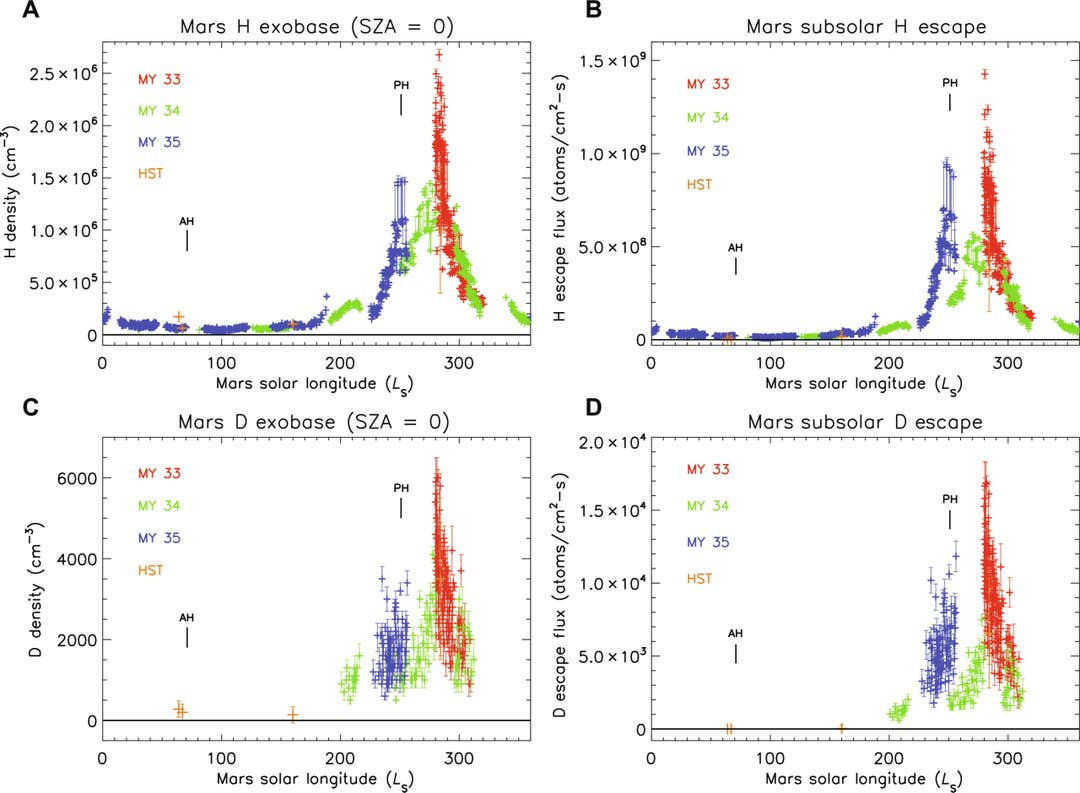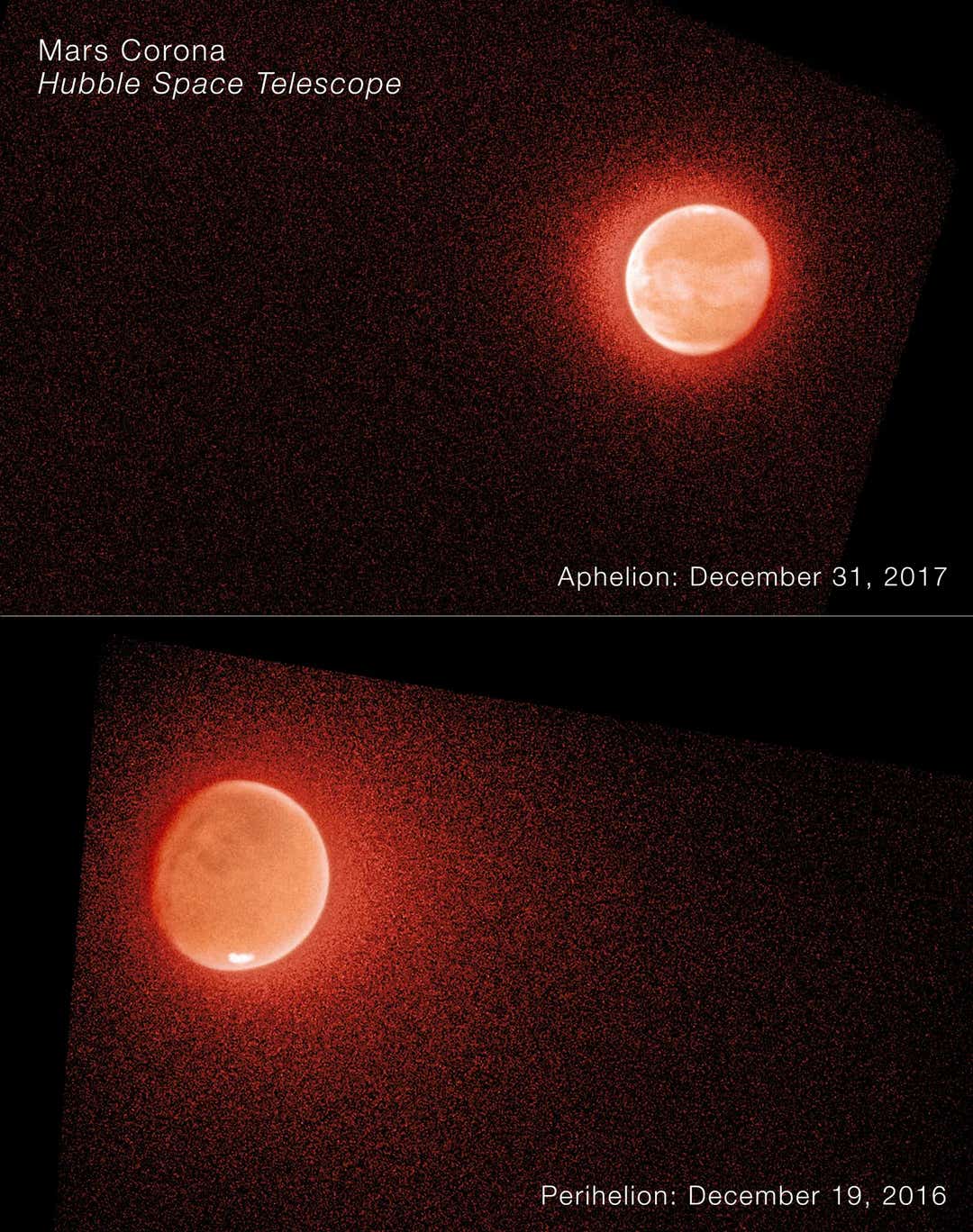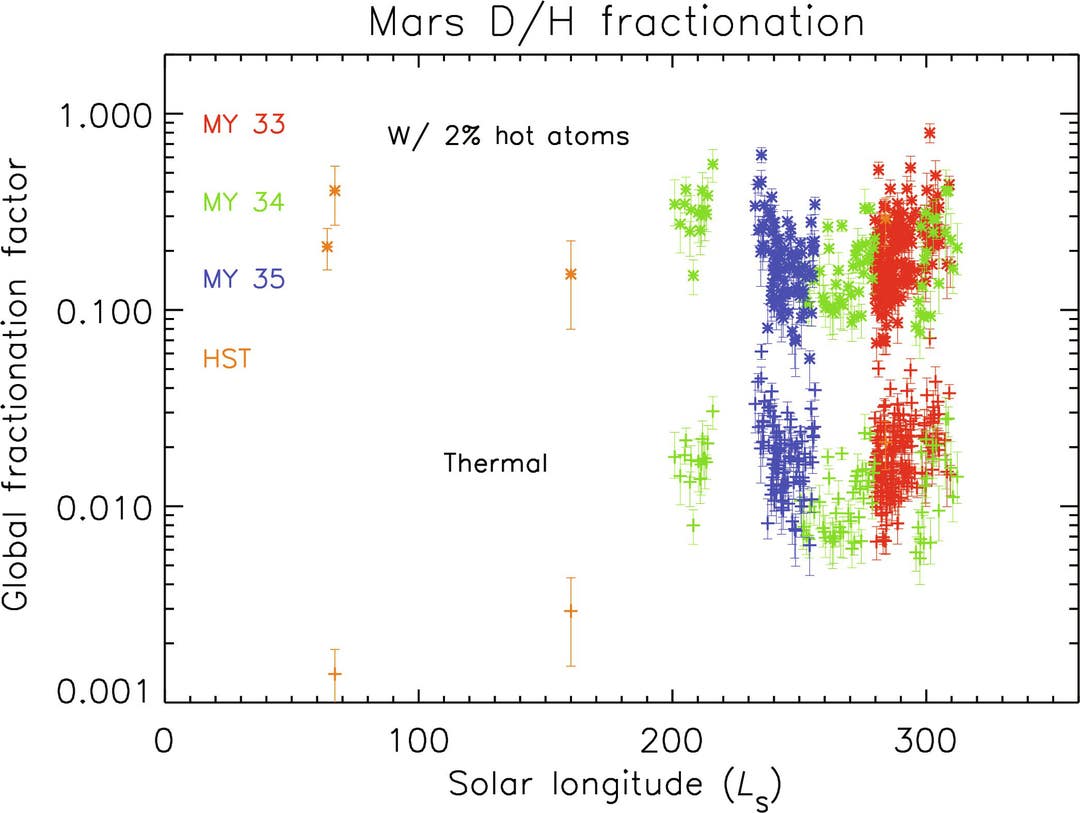https://www.thebrighterside.news/discoveries/nasa-researchers-discover-what-happened-to-mars-water/NASA researchers discover what happened to Mars’ water
Mars was once rich with flowing water. Today, it’s a cold, dusty desert marked by dried riverbeds and empty lake basinsMay 15, 2025 4:51 AM
Mars was once rich with flowing water. Today, it's a cold, dusty desert marked by dried riverbeds and empty lake basins.
Traces of ancient streams wind across its surface, hinting at a time when water covered much of the planet.
While some of this water is now locked deep underground, the fate of the rest has remained a mystery—until now.
Thanks to NASA’s Hubble Space Telescope and the Mars Atmosphere and Volatile Evolution (MAVEN) mission, researchers are uncovering new clues. These tools help track how Mars slowly lost its water over billions of years.
The data brings fresh insight into the forces that turned a once-wet planet into the dry world we see through telescopes today.
John Clarke, a researcher at Boston University's Center for Space Physics, is leading the charge and his team has focused on two possible outcomes for Mars' missing water. “Some of it likely froze into the ground,” Clarke says. “The rest may have broken apart into hydrogen and oxygen, with the light hydrogen atoms escaping into space.”
i=sI4tp91tXfaqAJSN
To test this, Clarke’s team uses Hubble and MAVEN to observe hydrogen atoms as they drift away from the Martian atmosphere.
These real-time measurements show how quickly hydrogen is disappearing today, giving scientists a way to estimate how much water has been lost over time.
By watching atoms vanish into space, the researchers are building a clearer picture of Mars’ past. With every data point, they piece together the story of how a planet once rich in lakes and rivers became dry, frozen, and nearly airless.
How Mars Is Losing Its Water to Space
On Mars, sunlight breaks apart water molecules in the atmosphere into hydrogen and oxygen atoms.
This process, known as
photodissociationWiki, releases two types of hydrogen: regular hydrogen and a heavier isotope called deuterium.
Now, Deuterium contains a neutron in its nucleus, giving it twice the mass of normal hydrogen and due to this increased mass, deuterium escapes Mars' atmosphere more slowly than hydrogen.
Over time, more hydrogen escapes than deuterium, leading to a higher ratio of deuterium to hydrogen in the atmosphere. Measuring this ratio allows scientists to estimate how much water was once present on the Red Planet, so by studying the current escape rates of these atoms, they can also learn about the processes that have influenced water loss over the last four billion years.
While the MAVEN spacecraft provides most of the data used in this research, it isn't sensitive enough to detect deuterium throughout the entire Martian year. Mars follows an elliptical orbit around the Sun, which means it swings far from the Sun during its long winter.
As a result, deuterium emissions become too faint for MAVEN to measure during this period. To fill in the gaps, Clarke's team turned to Hubble, which has been observing Mars since 1991, well before MAVEN's 2014 arrival.
By combining data from both missions, they were able to construct a complete annual cycle of hydrogen and deuterium escape rates for three Martian years, each equivalent to 687 Earth days.

 Mars-water-2-scaled.jpg (78.87 kB . 1080x793 - viewed 330 times)
Mars-water-2-scaled.jpg (78.87 kB . 1080x793 - viewed 330 times) ⬆️ Martian upper atmospheric H and D densities and escape fluxes at the exobase and SZA = 0 with Mars solar longitude LS measured over several MY. (CREDIT: Science Advances)
This collaboration between Hubble and MAVEN gave scientists the first comprehensive view of hydrogen atoms escaping into space from Mars. These findings help explain what happened to Mars' water and provide clues about the planet's ancient climate.
A Complex and Changing AtmosphereMars’ atmosphere is far more dynamic than previously thought. Clarke notes, "In recent years, scientists have found that Mars has an annual cycle that is much more dynamic than people expected 10 or 15 years ago."
The atmosphere heats up and cools down rapidly, sometimes in just a matter of hours.
This turbulence is influenced by Mars’ distance from the Sun, which varies by up to 40% over the course of a Martian year.
This new understanding of Mars' atmosphere has led to two major discoveries.
1. When the planet is closer to the Sun, water molecules rise through the atmosphere much more rapidly than expected, releasing hydrogen and deuterium at high altitudes.
2. The rapid fluctuations in hydrogen and deuterium escape rates suggest that these atoms need additional energy to escape Mars’ gravity.

 Mars-water-1.jpeg (176.42 kB . 1080x1368 - viewed 267 times)
Mars-water-1.jpeg (176.42 kB . 1080x1368 - viewed 267 times)⬆️ These are far-ultraviolet Hubble images of Mars near its farthest point from the Sun, called aphelion, on December 31, 2017 (top), and near its closest approach to the Sun, called perihelion, on December 19, 2016 (bottom). (CREDIT: Science Advances)
At normal atmospheric temperatures, only a small fraction of atoms has enough energy to escape. But when Mars is close to the Sun, the water molecules in its atmosphere absorb energy, which allows more atoms to escape into space.
In addition, solar wind protons and sunlight-driven chemical reactions provide extra energy, causing more atoms to break free from Mars’ atmosphere. This explains why the escape rates of hydrogen and deuterium vary so much throughout the Martian year.
Mars as a Proxy for Other Planets
The study of Mars’ water history is critical for understanding not only the Red Planet but also other Earth-sized planets in distant star systems. Astronomers have discovered many such planets, but their distance from Earth makes them difficult to study in detail.
Mars, along with Earth and Venus, resides in or near the "habitable zone" of our solar system, where liquid water could exist. However, each of these planets has evolved under vastly different conditions, providing scientists with natural laboratories for studying how planets in habitable zones can change over time.

 Mars-water-3.jpg (68.98 kB . 1080x813 - viewed 287 times)
Mars-water-3.jpg (68.98 kB . 1080x813 - viewed 287 times)⬆️ Dataset is for thermal (Jeans) escape alone, and top dataset includes 2% hot atoms at a temperature of 600 K. (CREDIT: Science Advances)
By examining Mars' past, scientists hope to gain insights into the conditions that allow liquid water, and potentially life, to exist on distant planets.
Clarke’s work, along with the data from Hubble and MAVEN, is helping to piece together the puzzle of water loss on Mars, a crucial step toward understanding the history of water in our solar system and beyond.
⬇️ Mars’ water met one of two fates: it either froze beneath the surface or split into hydrogen and oxygen molecules. (CREDIT: Shutterstock Images)










